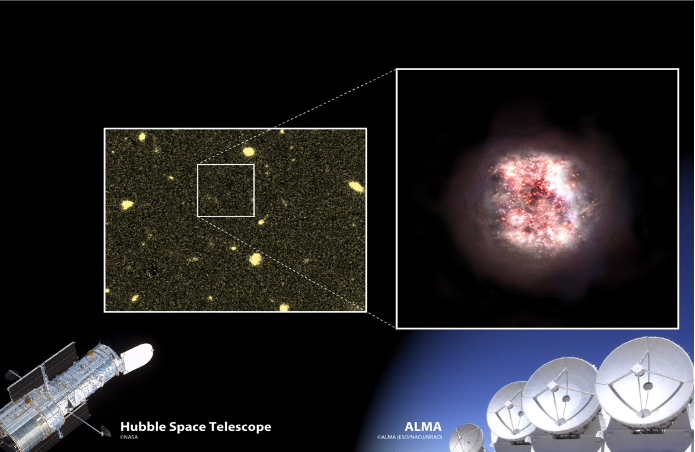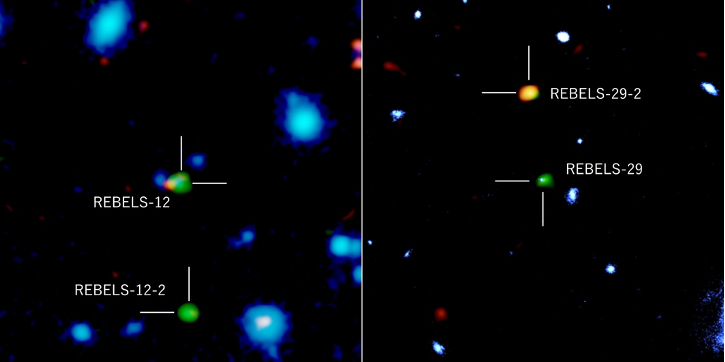
Two new galaxies formed at the dawn of the Universe and hidden behind interstellar dust discovered
The early Universe is probably much richer than it appears. The interstellar dust may conceal entire populations of galaxies that were previously unknown. In recent weeks, an international research team, including Sapienza University of Rome and the Scuola Normale Superiore of Pisa in Italy, has discovered two ancient galaxies dating back to about a billion years after the Big Bang, when the Universe was just under 8% of its age.
Using data from ALMA (Atacama Large Millimeter/submillimeter Array), an ultra-powerful radio interferometer located at an altitude of 5,000 metres in the Atacama Desert in Chile, Dr Yoshinobu Fudamoto of Waseda University in Japan, noticed a strong presence of dust and ionised carbon from areas of space previously thought to be empty. Fudamoto and his colleagues from the REBELS collaboration (in Italy, Raffaella Schneider and Luca Graziani of Sapienza University and Andrea Ferrara and Andrea Pallottini of the Scuola Normale Superiore, associated with the Italian National Institute of Astrophysics, INAF) investigated further these mysterious signals, which came from relatively close - tens of thousands of light-years - to the astronomical objects they were originally studying.
Their latest paper, published today in the journal Nature, includes the surprising revelation: the unexplained emissions belong to two previously unknown galaxies, not visible in the ultraviolet wavelengths because they are completely obscured by cosmic dust.
Named REBELS-12-2 and REBELS-29-2, the two galaxies were formed more than 13 billion years ago and show similar characteristics to galaxies of the same age, except for the massive obscuration due to the dust they produced, an effect that is typically only observed for much more advanced astronomical objects.The study reveals that the presence of these two objects could be just the tip of the iceberg of the existence of a population of galaxies previously unknown to astronomers.
The discovery suggests that the current census of early galaxy formation is most likely incomplete and will require more in-depth investigation. New instrumentation, such as the soon-to-be-launched James Webb Space Telescope (JWST), which will interact strongly with ALMA, will lead to significant advances in this field in the coming years.
"The discovery of such dust-obscured galaxies at a time when the Universe is still relatively young opens up interesting questions about the mechanisms of interstellar dust formation," says Raffaella Schneider of the Department of Physics at Sapienza - "The theoretical models and numerical simulations that we are developing will allow us to interpret these surprising results, preparing us for the extraordinary observations of the JWST."
The REBELS programme (Reionization-Era Bright Emission Line Survey) aims to observe the origin of the Universe billions of years ago when young galaxies had just begun to form stars and produce cosmic dust. Studying this primordial world is one of the last frontiers of astronomy, essential for the accurate and consistent construction of astrophysics models and the understanding of how the Universe evolves.
References:
Normal, dust-obscured galaxies in the epoch of reionization - Y. Fudamoto, P. A. Oesch, S. Schouws, M. Stefanon, R. Smit, R. J. Bouwens, R. A. A. Bowler, R. Endsley, V. Gonzalez, H. Inami, I. Labbe, D. Stark, M. Aravena, L. Barrufet, E. da Cunha, P. Dayal, A. Ferrara, L. Graziani, J. Hodge, A. Hutter, Y. Li, I. De Looze, T. Nanayakkara, A. Pallottini, D. Riechers, R. Schneider, G. Ucci, P. van der Werf & C. White - Nature 2021. https://doi.org/10.1038/s41586-021-03846-z
Further Information
Raffaella Schneider
Department of Physics
raffaella.schneider@uniroma1.it



